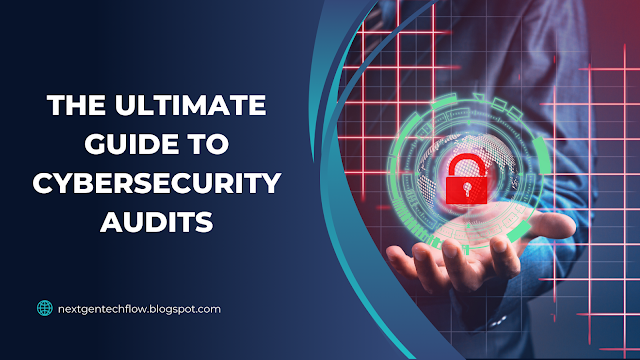
|
| The Ultimate Guide to Cybersecurity Audits |
Table of Contents
In today’s digitally driven world, safeguarding sensitive information is a critical priority for organizations. A cybersecurity audit is a systematic approach to evaluate and enhance an organization’s security posture. This comprehensive guide will walk you through everything you need to know about conducting an effective cybersecurity audit.
What Is a Cybersecurity Audit?
A cybersecurity audit is a meticulous process of assessing an organization’s IT infrastructure, policies, and procedures to identify vulnerabilities and ensure compliance with industry standards. It helps organizations detect weaknesses before cybercriminals exploit them.
Why Are Cybersecurity Audits Essential?
1. Protect Sensitive Data
Regular audits help safeguard confidential information such as customer details, financial records, and intellectual property.
2. Ensure Regulatory Compliance
Compliance with frameworks like GDPR, HIPAA, and ISO 27001 is mandatory for many organizations. Cybersecurity audits verify adherence to these regulations.
3. Mitigate Risks
Identifying and addressing vulnerabilities reduces the likelihood of data breaches, ransomware attacks, and other cyber threats.
Key Steps in Conducting a Cybersecurity Audit
1. Define the Scope
Clearly outline the objectives of the audit. Identify the systems, networks, and applications to be assessed.
2. Gather Information
Collect data about current security policies, IT assets, user permissions, and compliance requirements. Use tools such as vulnerability scanners and penetration testing software.
3. Identify Threats and Vulnerabilities
Assess the organization’s exposure to risks like phishing, malware, or insider threats. Prioritize vulnerabilities based on their severity.
4. Evaluate Security Controls
Examine existing controls, such as firewalls, encryption protocols, and access management systems, to ensure they are functioning optimally.
5. Document Findings
Compile a detailed report highlighting vulnerabilities, risks, and areas of non-compliance. Include actionable recommendations for improvement.
6. Implement Changes
Address identified weaknesses by updating software, tightening access controls, or conducting employee training sessions.
7. Monitor and Review
Cybersecurity is a continuous process. Regularly revisit audits to ensure sustained protection against evolving threats.
Key Components of a Cybersecurity Audit
1. Risk Assessment
Evaluate the likelihood and potential impact of various cyber threats.
2. Asset Inventory
Create a comprehensive list of IT assets, including hardware, software, and data repositories.
3. Access Control
Review who has access to critical systems and whether permissions align with their roles.
4. Network Security
Analyze the organization’s network for vulnerabilities in firewalls, routers, and Wi-Fi configurations.
5. Endpoint Security
Examine the security of devices like laptops, mobile phones, and IoT devices connected to the network.
6. Incident Response Plan
Assess the effectiveness of protocols for detecting, responding to, and recovering from cyber incidents.
7. Compliance Verification
Ensure alignment with industry regulations and best practices to avoid legal and financial penalties.
Common Challenges in Cybersecurity Audits
1. Lack of Resources
Conducting a thorough audit requires skilled professionals and advanced tools, which some organizations may lack.
2. Evolving Threat Landscape
New cyber threats emerge constantly, making it difficult to keep up.
3. Incomplete Data
Accurate audits depend on comprehensive information. Missing or outdated data can compromise results.
Best Practices for Cybersecurity Audits
1. Involve Stakeholders
Engage IT teams, management, and employees to ensure a collaborative approach.
2. Leverage Advanced Tools
Use specialized software like SIEM (Security Information and Event Management) tools to automate data collection and analysis.
3. Stay Updated
Regularly update security policies and infrastructure to adapt to new threats and compliance requirements.
4. Train Employees
Educate staff on recognizing phishing attempts and following secure practices.
5. Conduct Mock Drills
Simulate cyberattacks to test the effectiveness of security measures and incident response plans.
Cybersecurity Audit Frameworks
Several frameworks guide organizations in conducting cybersecurity audits effectively:
1. NIST Cybersecurity Framework
Provides a comprehensive approach to identifying, protecting, detecting, responding to, and recovering from cyber threats.
2. ISO/IEC 27001
Focuses on implementing and maintaining an information security management system (ISMS).
3. COBIT (Control Objectives for Information and Related Technologies)
Helps organizations manage and govern IT security.
The Role of Third-Party Auditors
Hiring third-party experts ensures an unbiased evaluation of an organization’s cybersecurity measures. They bring specialized expertise and tools to uncover hidden vulnerabilities.
FAQs About Cybersecurity Audits
1. How often should cybersecurity audits be conducted?
We recommend performing audits annually or after significant changes in IT infrastructure.
2. What is the difference between a cybersecurity audit and a penetration test?
An audit is a comprehensive assessment of security measures, while a penetration test specifically evaluates system vulnerabilities by simulating attacks.
3. Can small businesses benefit from cybersecurity audits?
Absolutely. Cyberattacks do not discriminate based on business size, and small businesses are often targeted due to weaker defenses.
4. What is the cost of a cybersecurity audit?
Costs vary depending on the scope, complexity, and whether third-party services are used. A small-scale audit can cost a few thousand dollars, while larger audits may be significantly more expensive.
5. What happens if vulnerabilities are found during the audit?
Identified vulnerabilities should be prioritized and addressed immediately to minimize risk exposure.
Conducting regular cybersecurity audits is essential for protecting sensitive information, ensuring regulatory compliance, and mitigating risks. By following a structured approach and leveraging best practices, organizations can significantly enhance their security posture and resilience against cyber threats. Whether you're a small business or a large enterprise, investing in robust cybersecurity audits is a proactive step toward securing your digital future.

